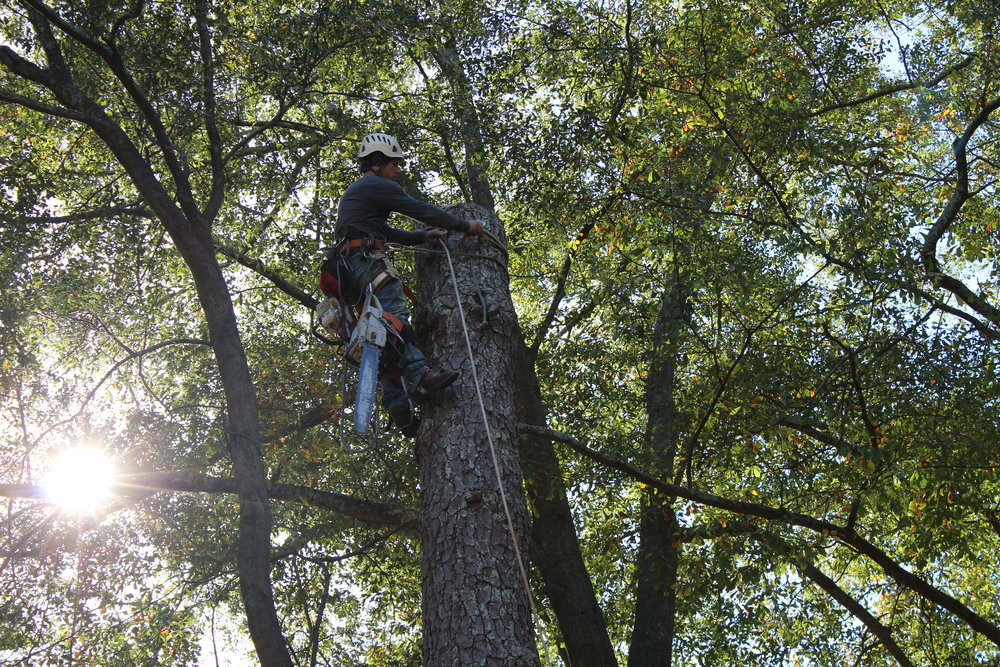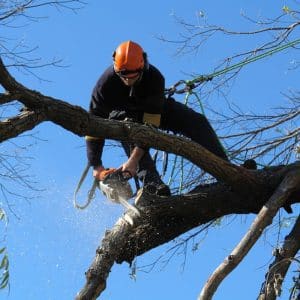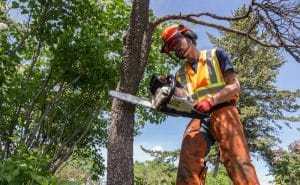Trees can add natural beauty, shade and environmental benefits to your property. However, there may come a time when you need to remove a small tree for a variety of reasons. Whether it’s creating a new landscaping area, removing safety hazards, or dealing with undesirable species, knowing how to properly remove shrubs is a valuable skill for homeowners and gardeners . . . .
In this comprehensive guide, we’ll walk you through the step-by-step process to safely and effectively remove small trees from your yard. This information is designed to give you control over your outdoor property and ensure the success of your property.
Now, let’s begin the journey to a treeless yard and a much safer and warmer outdoor space!
Assessing the Situation
Before you dive in to remove a small tree from your property, it’s important to thoroughly assess the situation. These steps help you make informed decisions and ensure the safety and success of your tree removal project.
Select the tree type and size
Tree Species: Start by identifying the tree species you want to eliminate. Different trees may require different methods of removal. Some species have shallow roots, while others have deep roots.
Tree Size: Measure the height and size of the tree. Small trees can vary greatly in size, and knowing their size will help choose the right tools and methods for removal.
Check the health and stability of the tree
Health Inspection: Examine the tree for signs of disease, rot, or insect infestation. Removing a severely diseased tree can be even more dangerous, so you need to be extra careful.
Stability test: Check the stability of the pole by looking for it to float or warp. A hanging tree can fall in an unexpected place during removal, so you will need to plan accordingly.
See statutory regulations or licenses
Local Regulations: Check with your local laws regarding tree removal. Some areas have tree removal laws, especially in the case of protected trees or property. Failure to comply with this rule may result in fines or legal action.
Permits: Check if you need any permits to legally remove the tree. Contact your local government or forest department to inquire about permit requirements and the application process.
Property Boundaries: Make sure the tree you plan to remove is within your property boundaries. Removing a tree from someone else’s property without permission can lead to legal complications.
After careful consideration of the situation, you will have a clear understanding of the nature of the tree, potential hazards, and legal requirements. This knowledge will guide the process of removing the small trees and help you plan a successful process. In the next section, we’ll delve into gathering the tools and equipment you’ll need for the job.
Gathering the Necessary Tools to Remove Small Trees
To successfully remove a small tree, you will need the right tools and equipment at your disposal. Proper equipment ensures efficiency and safety throughout the tree removal process. Here’s a full list of what you’ll need:
Chainsaws: Chainsaws are a basic tool for cutting tree trunks and branches. Choose the right screw size based on the size of the tree.
Hand saws for pruning saws: These small saws are easy to cut small branches and limbs and can be used in tight areas where chainsaws can’t reach
Shovel: A sturdy shovel is needed to dig around the base of the tree, loosen the soil and expose the roots.
Mattock or pickax: These tools are useful for breaking up hardened soil and removing stones near the tree roots.
Root saw or ax: For trees with normal roots, a root saw or ax can help to cut the root properly.
Safety Equipment: Safety glasses, ear protection and a hard hat are essential to protect against aircraft debris and accidents.
Gloves: Durable gloves provide a better grip on tools and protect your hands from scratches and scrapes.
Safety glasses: Protect your eyes from debris, sawdust and falling branches with safety glasses or goggles.
Ear protection: A good pair of ear plugs or ear plugs will protect your ears from the noise created by chains and other devices.
Hard Hat: Wear a hard hat to protect your head from branches or debris.
Safety Precautions before Tree Removal
Safety should be your top priority when removing small trees. While the technique can be beneficial, it also comes with inherent risks. You can reduce the chance of accidents and ensure a safe tree removal by following these safety precautions:
Appropriate clothing
Safety glasses or goggles: Protect your eyes from flying objects, sawdust and wood shavings. Make sure your eye protection is ANSI-rated for impact resistance.
Ear protection: Use ear plugs or earplugs to protect your ears from the loud noise created by power tools such as chains.
Hard Hat: Wear a hard hat to protect your head from branches, equipment, or debris.
Gloves: Durable, non-slip gloves will provide a comfortable grip on tools and protect your hands from scrapes and bruises.
Chainsaw Chaps: If you use a chainsaw, consider wearing chainsaw chaps or pants in case you get kicked.
A safe working environment
Clear the work area: Keep the work area around the tree clear of obstacles, debris, and fall hazards.
Secure the area: Mark the work area with neck or caution tape to prevent access. Talk to family members or neighbors about tree removal for safety.
Escape Routes: Plan escape routes in case the tree falls unexpectedly. Always have a clear path away from a falling tree.
Chainsaw safety
Formal training: If you do not have locksmith experience, consider getting formal training or working with an experienced professional.
Check the chain: Make sure your chain is working properly with a sharpened chain. Follow the manufacturer’s instructions for maintenance and safety.
Kickback awareness: Watch out for chainsaw kickbacks, which can be sudden and severe. Hold firmly and avoid clipping with the end of the screws.
Pruning precautions
Check directions: Check the roughness of the frame and determine the natural direction of fall. Plan your cutting and cutting directions accordingly.
Notch and Back Cut: Use proper notching and back-cutting techniques to prevent tree fall. Make sure your cuts are even so the tree doesn’t fall off unexpectedly.
Stay away from the tree fall: Keep your distance from where the tree wants to fall. Never stand directly behind him.
Communication: If you work with a team, establish clear communication signals to coordinate tasks and ensure everyone’s safety.
First Aid and Emergency Planning
First Aid Kits: Have a first aid kit on hand in case of minor injuries.
Emergency Communications: Keep a phone nearby and call for help in case of a serious accident.
Taking these safety precautions seriously can greatly reduce the risks associated with small tree removal. Remember that if you ever feel unfamiliar with any aspect of the process or are faced with a difficult situation, it is wise to seek the advice of a tree removal professional.
Methods to Remove Tree Removal Small Trees
Removing small trees can be an easy process if you follow the right steps and use the right techniques. In this section, we’ll walk you through the entire tree removal process, including the three most common methods: hand pulling, digging and lifting, cutting, and tree removal
1. Hand drawn method
Inspection: Make sure the roots are shallow and the tree is very small. This method is best suited for seedlings and small trees with few roots.
Prepare the site: Sweep the area around the tree and remove any vegetation or obstacles that may interfere with the process.
Loosen the soil: Use a shovel or matt to dig around the base of the tree and loosen the soil. This will make it easier to remove the tree.
Grab and pull: Hold the tree trunk as close to the ground as possible and pull firmly in the direction you want it to fall. Use your body weight and leverage to help with the pull.
Root Removal: Once the tree is out of the ground, check the hole for any remaining roots. Remove it to prevent regrowth.
2. Mining methods and production
Reference: This method is suitable for relatively large trees with deep roots. Make sure you have the physical strength and equipment to do the job.
Field Preparation: Clear the area around the tree and make trenches around the tree, exposing as many roots as possible.
Dig a trench: Use a shovel or mattock to dig a trench around the base of the tree, trimming the roots as you go. The bays should surround the tree.
Raise the tree: Insert a pry-bar or leverage tool into the groove and apply leverage to lift the tree root ball off the ground. For large trees, you may need help from a friend or winch.
Root inspection and removal: After lifting, check for any remaining roots in the hole and remove them to prevent regrowth.
3. Methods of harvesting and pruning
Reference: This method is ideal for trees with extensive roots or when it is necessary to preserve the surrounding soil.
Prepare the area: Sweep the area around the tree, making sure there are no obstacles or structures in the fall area.
Notch and Back Cut: Make a horizontal notch cut on the side of the tree facing the direction you want it to fall. Next, cut the back of the trench slightly upwards but on the opposite side of the tree. This creates a hinge that guides the fall of the tree.
Pruning: If the tree is large, consider pruning the one opposite the cut pit to control where it will fall.
Tree Removal: If the tree has fallen, you can remove the tree by using a scraper or digging around to cut off the remaining roots.
Disposal of Removed Trees
If you successfully remove a small tree from your property, the job is far from done. Proper removal of trees and debris is important to ensure a clean and safe outdoor space. Here are some environmentally friendly and effective ways to dispose of tree removal.
Compost materials
Chipping and Shredding: If you have a chipper or shredder, you can process tree branches and small debris into chippers or chisels.
Compost: Use wood chips or sawdust as a valuable addition to your compost pile. Wood chips break down slowly and can increase the nutritional value of your compost, improving its quality.
Mulching: Spread mulch or mulch around your garden or landscape beds. This will help retain moisture, control weeds and improve soil health.
Recycling
Logs and logs: If the tree removed was of appropriate size and quality, consider salvaging the logs for logs or logs. This consistent approach can reduce waste and provide value.
Recycling Centers: Some areas have recycling centers that accept scrap wood. Check with local recycling centers to find out their disposal policies.
Municipal pickup
Yard waste collection: Many municipalities offer yard waste collection services. Check with your local government or waste management agency to see if they offer curbside pickup of wood debris.
Trash: Some areas have local compost systems that accept yard waste, including small trees and twigs. Find a nearby compost facility or drop-off locations.
Removal of soil erosion
Last resort: Disposal may be your last resort. It’s not the most environmentally friendly option, but if no other options are available, contact your local landfill for information on tree removal options.
DIY projects
Reuse wood: If you’re a skilled woodworker or DIY enthusiast, consider repurposing salvaged wood into furniture, art, or other creative projects.
Firewood: If appropriate, store wood in a fireplace or outdoor fireplace, if it is safe and allowed in your area.
Personnel Services
Tree Removal: If you have used a tree removal service, ask if they offer debris removal as part of their service. They may have their own disposal methods.
When disposing of stripped trees, refer to local rules and guidelines for waste disposal. Avoid illegal dumping or burning without proper permits. By adopting eco-friendly methods of disposal and recycling where possible, you can minimize the environmental impact of your tree removal project on while maintaining a clean and sustainable outdoor environment
Aftercare and Maintenance
Removing a small tree from your property is just the beginning of your park maintenance journey. To ensure your yard stays tree-free and allows you to grow well in other areas, follow these backup and maintenance steps:
Filling the Hole
Level the soil: Remove the stem and roots to level the soil. Use a shovel or garden rake to level the soil where the tree once stood.
Soil conditioning: Consider adding organic matter such as compost or topsoil to improve soil quality. This provides a good foundation for future landscaping or planting.
Grass seeding or sod: If you want to restore a grassy area, you may want to seed or sod and keep a green lawn.
Inhibition of regrowth
Tree Removal: If the tree was not removed when the tree was first removed, consider using a tree scraper to remove it. The trees are often able to produce new branches, allowing them to grow again.
Apply herbicide: You can spray with a suitable herbicide to prevent regrowth of the remaining tree. Follow the manufacturer’s instructions and safety precautions closely.
Regular inspection: Check the area periodically for new growth, especially on the old tree. Remove any twigs or branches as soon as possible to prevent the tree from reappearing.
Land management
Reimagine your space: When you remove a tree, you have an empty canvas for new landscaping. Take this opportunity to plan and design a landscape that suits your interests and needs.
Choose new plants: Choose native or ornamental plants that thrive in your area and complement your landscaping. Be mindful of their growth habits and space needs.
Mulch and Water: Apply mulches to retain water, control weeds and improve soil health. Ensure adequate irrigation for new plant growth.
Routine maintenance
Pruning and Pruning: Check and prune nearby trees and shrubs to prevent overgrowth and maintain the desired aesthetics of the landscape.
Pest and Disease Management: Inspect your property for signs of pests or diseases and take appropriate actions to address any issues promptly.
Fertilizer: Apply fertilizer as needed to promote healthy plant growth and maintain the overall health of your soil.
Annual Cleanup: Perform seasonal thorough yard maintenance to remove fallen leaves, debris and dead plant material.
Employee support
Consult an arborist: If you are unfamiliar with tree care or are experiencing challenges with your landscape, consult a certified arborist or landscape architect. Expert guidance and solutions can be provided.
Planned maintenance: Consider regular visits with a professional to ensure the long-term health and beauty of your exterior.
FAQs
Is it possible to remove a tree by myself, or should I always hire a professional?
While it’s possible to remove small trees on your own with the right tools and knowledge, it can be a challenging and potentially dangerous task. Hiring a professional tree removal service is recommended for larger trees, trees near structures, or when you’re unsure about the process. Safety should always be a top priority.
How can I tell if a tree is diseased or dying and needs to be removed?
Signs of a diseased or dying tree include dead or brown branches, sparse foliage, fungal growth on the trunk, and visible decay. If you suspect a tree on your property is in poor health, consult with an arborist for a professional assessment before deciding on removal.
What permits or regulations should I be aware of before removing a tree from my property?
Regulations regarding tree removal vary by location and may include local ordinances, tree preservation laws, or requirements for protected species. Contact your local government or forestry department to inquire about necessary permits and regulations in your area before starting any removal project.
Can I use the wood from the removed tree for firewood or woodworking projects?
Yes, you can often repurpose the wood from a removed tree for firewood or woodworking, provided it’s suitable for the intended use. Consult with a professional or an experienced woodworker to determine the wood’s quality and suitability for your specific needs.
What are the signs of regrowth, and how can I prevent a removed tree from growing back?
Signs of regrowth include new shoots or sprouts emerging from the stump or remaining roots. To prevent regrowth, ensure you remove the stump entirely or apply an appropriate herbicide to inhibit new growth. Regular monitoring and prompt removal of any sprouts are essential to prevent the tree from coming back.
Conclusion
Congratulations to you! Now you know exactly what steps and precautions to take to remove small trees from your property. Tree removal can be an expensive task, but with the right knowledge and equipment, it can be handled safely and effectively.
With this knowledge, you are well equipped to start or make the right decision for your tree removal project should you choose to hire professional help. Remember that safety is paramount throughout the entire process, and if you encounter any challenges beyond your expertise, do not hesitate to consult or hire a certified arborist or tree remover





